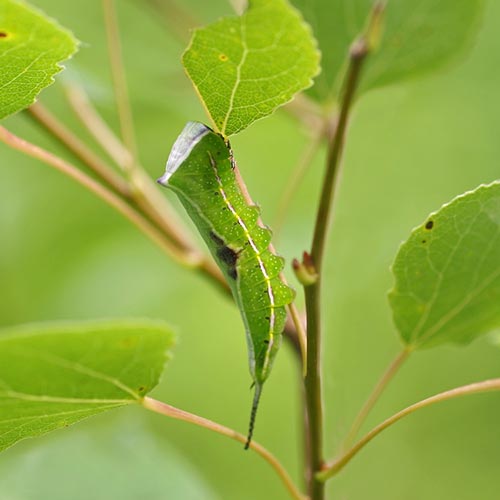Salutations, BugFans,
Prominent Moths
The Prominents (family Notodontidae) are a bunch of long-winged, hairy, often-drab, mostly-tropical moths. Of the 3,800 species in the family, 138 are found in North America (half of them in Eastern forests). They are called “prominent” because in many species, tufts of hair on the back edge of the forewing are upturned when the moth is sitting (OK—the BugLady doesn’t quite get that explanation, either). According to Borrer and DeLong, in An Introduction to the Study of Insects, “Notodontidae” comes from not, meaning back, and odont, meaning tooth. The moths, most of which are nocturnal, typically sit with wings tented over their backs or rolled like a tube/stick—well-camouflaged as they perch during the day. Adults don’t feed, and most moth collections contain males, which, for some reason, come more readily to light than females.
[metaslider id=1430]
Prominents generally lay their eggs on the undersides of leaves, where the larvae may initially feed gregariously. Caterpillar menus are generally limited to one or just a few host plants per species, and they often perch on a leaf’s edge as they feed on it. As a group, these large-headed caterpillars are gaudier than their elders and may be decorated with an array of spines, tubercles or humps.
The prolegs at the tip of the abdomen may be vestigial or highly modified, and caterpillars may be capable of chemical defense. Prolegs are the fleshy “false” legs located on the underside of the abdomen (the true legs are on the thorax, but when you have a long, columnar body, it helps having a little assist towards the rear). Prolegs are used in locomotion and are outfitted with tiny hooks (crochets) for gripping. They are not jointed and mostly work hydraulically. The anal prolegs are the final set, on the 10th abdominal segment. When alarmed, Prominent caterpillars raise both ends, holding onto the substrate with their middle prolegs. Most spend the winter as larvae.
Linden Prominent
Not much is known about the lifestyle of the Linden Prominent (Ellida caniplaga) because its larval days are spent high up in basswood trees. LPs are most commonly seen when they descend in preparation for their underground pupation. In fact, the BugLady had a “sky-is-falling” moment as she was photographing the caterpillar trekking across the ground—she heard a small pop as something hit the ground behind her. Basswoods are notorious for their “self-pruning,” but it was only a second caterpillar that had bounced into a crack in the basswood bark.
While the moths are fairly unremarkable, the caterpillars are quite varied in color and pattern. The black spots on the top of the head are diagnostic, along with a hump toward the end of the abdomen. LPs overwinter as pupa. Wagner, in Caterpillars of Eastern North America, tells us that there are “at least two generations over much of the East.” He also says that “When harassed, the larva will raise its head and display its bright, shiny black mandibles.”
Linden Prominents can be found in woodsy areas east of the Great Plains and into southern Canada. There are other members of the genus south of the Rio Grande, but the LP is the only Ellida north of it.
Black-Edged Prominent
The Black-Edged Prominent (Cerura scitiscripta) is found in fields and woodlands, especially near wetlands, in the eastern two-thirds of North America where the caterpillar’s host plants—poplar and willow (and sometimes cherry)—are found. The adults and the larvae are variable. This moth reminds the BugLady of a Snowy Owl, and, oh, what an awesome caterpillar!
[metaslider id=1434]
The BEP caterpillar has drastically modified anal prolegs, which are Plan A in its defense strategy. According to Wagner: “At rest the caterpillar is cryptic; its movements are slow and deliberate. Once alarmed, the warningly-colored portions of the anal prolegs are everted and the legs are curled upward over the body and flung about.” The caterpillar accomplishes this feat by diverting blood into the prolegs (remember those little rubber toys that you squeezed and their eyes bugged out?). See the pictures of a related caterpillar in action. Then Wagner describes Plans B and C: “The caterpillar also rears up to display its false head [the magenta border and black eyespots] and separates its shiny black mandibles. Ultimately, the caterpillar may release a spray of acid from a gland on the venter of the first thoracic segment”.
By the way, the tree crickets are in full throat and loving the heat. Review your Tree Cricket Facts and then go outside, night or day, and have a listen.
The BugLady

